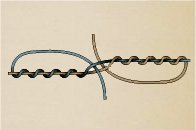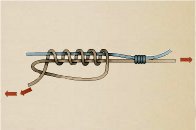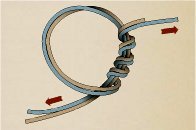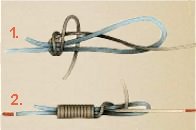“Our added winter moisture and active calling period led to a very long nesting and hatching season, starting in late April and extending into early summer, with chicks hatching as late as early July,” O’Dell said. “From a population standpoint, we are out of a deficit for the first time since 2001-2002. Quail are starting to pop up in places they haven’t been seen in a while.
“If you’ve never had the chance to experience what Arizona quail hunting built its name on, then this would be the year to get out and enjoy it.”
Meanwhile, hunters should note that the season for Mearns’ quail doesn’t begin until Dec. 4. It’s summer rainfall that plays a key role in nesting success and population numbers of this species. After a spotty and relatively weak monsoon across southern Arizona, these birds are likely to be abundant only in pockets that received sufficient precipitation this summer.
A valid Arizona hunting or combination hunt and fish license is required for all hunters 10 and older. Those hunters under 10 must either have a valid hunting or combination hunt and fish license, or be accompanied by an adult who possesses a valid hunting or combination hunt and fish license. Licenses can be purchased online or at license dealers statewide. A youth combination hunt and fish license (ages 10 to 17) is $5.
The general bag limit is 15 quail per day in the aggregate, of which no more than eight may be Mearns’ quail (when the Mearns’ season opens Dec. 4). The general possession limit is 45 quail in the aggregate after opening day, of which no more than 15 Gambel’s, scaled or California quail in the aggregate may be taken in any one day. After the opening of the Mearns’ season, the 45-quail possession limit may include 24 Mearns’ quail, of which no more than eight may be taken in any one day.
More quail-hunting information can be found on the department’s website at https://www.azgfd.com/Hunting/. Another resource for both new and experienced hunters alike is “An Introduction to Hunting Arizona’s Small Game.” Written by Randall D. Babb, the 196-page, full-color book covers where and how to hunt small game birds (like quail), squirrels, rabbits, ducks and geese. It also includes how to prepare and cook your harvest, with illustrations and recipes. The book can be ordered for $16.95 at www.azgfd.gov/publications.
Finally, hunters should check out O’Dell’s techniques for field-dressing quail at https://www.youtube.com/watch?v=3gRwZAcWzzk.
####
Publishers Notes: OUT OF STATE HUNTERS, FISHERMEN & OUTDOOR ENTHUSIASTS; Due to the Covid 19 pandemic, there could be limitations for OUT of STATE hunters, fishermen and other outdoor enthusiasts to include a 14-day quarantine requirement or negative COVID-19 testing alternative. Please check with the State's Department of Natural Resources BEFORE you travel or apply for the 2020 Fall Hunts.
Line Joining Knots
Tying line to line is critical. And when it's called for (for example, when you have a killer rig on 15-pound test line and you want to attach it to the 20-pound test line on your reel without having to retie the whole rig) you need a really good knot. These knots are tested and reliable for joining two pieces of fishing line.
The Backcountry Press
There are a large variety of knots for the outdoors including hunting, fishing or boating and each knot has specific properties and suitability for a range of tasks. Some knots are well-adapted to attach to particular objects such as another rope, cleat, ring, or stake. Other knots are made to bind or constrict around an object. Choosing the correct knot for the job at hand is one of the most fundamental aspects of using knots well. (Some Video Instructions are Included)
© 2020 TBC Press - All Rights Reserved Website Design by:
K N O T S
Blood Knot -- click for step by step video
A blood knot (Barrel knot) is most usefully employed for joining sections of monofilament nylon line while maintaining a high portion of the line's inherent strength.
Other knots used for this purpose can cause a substantial loss of strength. In fly fishing, this serves to build a leader of gradually decreasing diameter with an easy cast fly line attached at the large diameter end and the fly or hook at the small diameter end.
Double Uni-Knot
It's two knots tied back to back, then placed together to form a strong connection. Leave plenty of line at the end of the knot on each piece of line you're joining. The ends help pull the two knots into one. Clip ends short after the double knot is created.
The principal drawback to the blood knot is the dexterity required to tie it. In tying the blood knot, the two lines to be joined are overlapped for 6-8 cm with the short ends of the two lines in opposite directions. The short end of one line is then wrapped 4-6 times around the second line and the remaining portion of the first short end brought back and passed between the lines at the beginning of the wraps. The short end of the second line is then wrapped 4-6 times around the first line and the end of this line brought back and passed through what is now an oval space between the first wrap of each set.
The above method has been called by Stanle Barnes (Anglers' Knots in Gut & Nylon, 2nd ed., 1951) "outcoil", and is contrasted with the method that resembles the finished knot from the start, "incoil". The images here are incorrect to present the finished knot as having its free/"tag" ends go from the center of the knot to the extreme ends; they in fact will immediately coil around the standing parts towards the extreme ends. In fishing line, and in other material if not deliberately set snug and maybe re-set after some initial tensioning, the outcoil form will transform into the incoil form.
The lines are moistened and the wraps tightened by pulling on the long ends of the line. This causes the wraps to tighten and compress, creating 2 short sections of 'barrel', which look much like a 'hangman's knot', that slide together. The short ends of the line are then trimmed close to the wraps, or one of the ends may be left intact to be used for a second fly or lure, called a 'dropper.'
This knot requires five turns of line, with each tag end around the overlapped standing end of line. Make one series of turns and tuck the tag end between the two lines. Then repeat with the second line. You can even tie together lines of different diameter. It's good for tying 15-pound to 20-pound test line but not so great for tying 15-pound to 50-pound test line.
Surgeon's Knot -- click to watch step by step video
The surgeon's knot is a simple modification to the reef knot. It adds an extra twist when tying the first throw, forming a Double overhand knot, thus adding friction which makes the knot more secure.
This knot is named for the fact that it is commonly used by surgeons in situations where it is important to maintain tension on a suture. Surgeon's knots are used in fly fishing as well as in tying quilts.
This knot makes it easy to join two lines, but one line must be short, since you have to bring the one end through the formed overhand loop. As with other lines, use a lot of overlapping line so that you can pull on all four ends to make it properly tight. Work with both lines together as you tie this, and make sure both loops are the same size to assure a strong knot.
Albright Knot -- click for step by step video
One of the most reliable knots for tying together two lines of unequal diameter, the Albright works well when you have to tie the 15-pound test line on your rig to the 20-pound test you currently have on your reel spool or when tying monofilament backing to a fly line.













